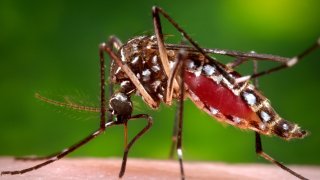
2006
This 2006 photograph depicted a female, Aedes aegypti mosquito, from a left lateral perspective, while she was in the process of acquiring a blood meal from her human host. The feeding apparatus consisted of a sharp, orange-colored stylet. When not feeding, the stylet would be covered in a soft, pliant sheath, known as the labellum, which was shown here, retracted exposing the sharp stylet. The orange color of the stylet was due to the red color of the blood, as it migrated up the thin, sharp translucent tube. Note how her distended abdomen exhibited a red coloration, as it filled with the insect’s blood meal.
This 2006 photograph depicted a female Aedes aegypti mosquito while she was in the process of acquiring a blood meal from her human host, who in this instance, was actually the biomedical photographer, James Gathany, here at the Centers for Disease Control. The feeding apparatus consisting of a sharp, orange-colored “fascicle”, which while not feeding, is covered in a soft, pliant sheath called the “labellum”, which retracts as the sharp stylets contained within pierce the host’s skin surface, as the insect obtains its blood meal. The orange color of the fascicle is due to the red color of the blood as it migrates up the thin, sharp translucent tube. Note the distended abdominal exoskeleton, which being translucent, allowed the color of the ingested blood meal to be visible.
DF and DHF are primarily diseases of tropical and sub-tropical areas, and the four different dengue serotypes (DEN-1, DEN-2, DEN-3, and DEN-4), are maintained in a cycle that involves humans and the Aedes mosquito. However, Aedes aegypti, a domestic, day-biting mosquito that prefers to feed on humans, is the most common Aedes species. Infections produce a spectrum of clinical illness ranging from a nonspecific viral syndrome to severe and fatal hemorrhagic disease. Important risk factors for DHF include the strain of the infecting virus, as well as the age, and especially the prior dengue infection history of the patient.
A West Nile virus infection from a mosquito bite in an area of Moreno Valley where infestations are present will require pest control spraying over a 146-acre space, vector control officials said Friday.
The WNV infection was confirmed in Riverside County in the last week, according to the California Department of Public Health.
The county Department of Environmental Health has scheduled "ultralow volume" insecticide spraying in two adjoining locations between 5 a.m. and 7 a.m. Wednesday.
Agency spokesman Brent Casey said the first targeted area will be in the vicinity of Celebration Park, covering roughly 116 acres, bordered by Cactus Avenue to the north, JFK Drive to the south, Moreno Beach Drive to the east and Oliver Street to the west.
Casey said the second target will be a 30-acre space bordered by the Ridge Crest Park Golf Course to the north, JFK Drive to the south, Pete Dye Street to the east and Moreno Beach Drive to the west.
Anti-mosquito spraying involves the use of chemicals approved by the U.S. Environmental Protection Agency. Pesticides are emitted as a mist dispersed from machines anchored in the backs of pickup trucks.
Officials recommended that during operations, residents stay indoors and keep windows closed until at least 15 minutes after the trucks have departed.
Local
Get Los Angeles's latest local news on crime, entertainment, weather, schools, COVID, cost of living and more. Here's your go-to source for today's LA news.
In addition to the most recent case, two other human West Nile virus infections have been documented countywide so far this year. Statewide, a total of 58 WNV infections have been recorded, the largest number of them in Northern California, according to the CDPH. There have been two WNV-related deaths -- in Los Angeles and Orange counties.
Mosquitoes typically become carriers of the virus after feeding on an infected bird and can then spread the potentially lethal strain to animals and humans. Those at greatest risk include seniors and individuals with compromised immune systems.
Symptoms may never materialize, but can include fever, headache, nausea, body aches, skin rashes and swollen lymph nodes.
Mosquito season in Southern California generally spans May to October.
To reduce exposure to mosquitoes carrying WNV, residents are urged to:
-- spend as little time as possible outdoors at dawn or dusk, when mosquitoes are generally on the move;
-- wear pants and long-sleeved shirts during outdoor activity in mosquito-prone places;
-- use insect repellent;
-- ensure door and window screens are fitted properly to keep bugs out; and -- get rid of standing water, aside from pools properly treated with chemicals.
Anyone with concerns should contact the Department of Environmental Health at 951-766-9454.